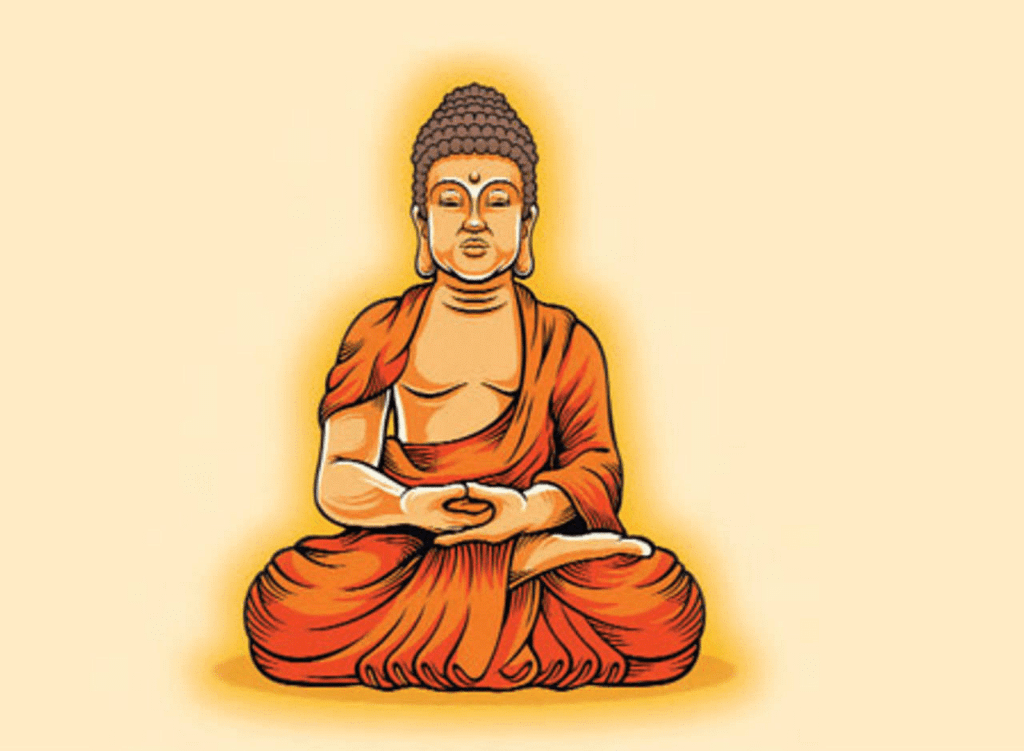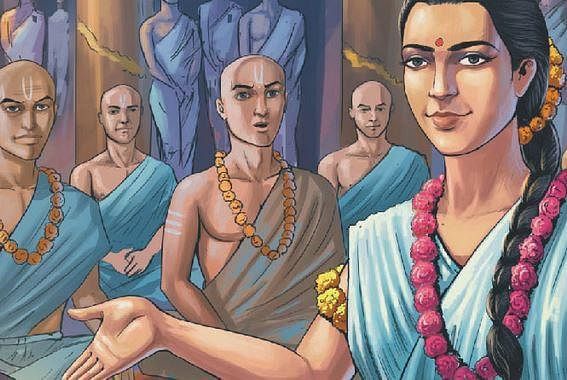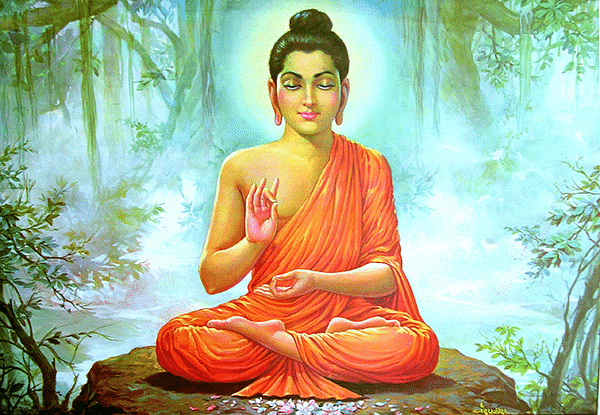Short & Long Question Answers: New Questions & Ideas | Social Studies (SST) Class 6 PDF Download
Short Question and Answers
Q1: What is thirst or tanha?
Ans: Buddha taught that life is full of suffering and unhappiness because we have unlimited cravings and desires. Buddha described this as thirst or tanha.
 BuddhaQ2: Write short note on Shankaracharya.
BuddhaQ2: Write short note on Shankaracharya.
Ans: Shankaracharya, with his remarkable reinterpretations of Hindu scriptures such as the Upanishads or Vedanta, had a profound influence on the growth of Hinduism. He was born in 788 AD in a village named Kaladi on the banks of the river Purna in Kerala.
Q3: Write about Vardhamana Mahavira.
Ans: He was the prince of the Lichchhavis, a group that was part of the Vajji sangha. At thirty, he left home and went to live in a forest. For twelve years, he led a hard and lonely life, at the end of which he attained enlightenment.
Q4: List the reasons for the spread of Jainism among the common people.
Ans: Labourers, slaves, and merchants joined the Sangha. Other groups, like the Brahmins, Kshatriyas, and courtesans, joined it. This is one of the reasons for the spread of Jainism among the common people.
Q5: Write about Gargi.
Ans: Gargi was one of the few learned women who had contributed to the creation of the Upanishads. She was the daughter of sage Vachaknu, and her inclination towards academics was very conspicuous from an early age. She has composed several hymns questioning the origin of all existence.

Q6: Who where bhikkhus and the bhikkhunis?
Ans: These were the members of the Buddhist sangha. They meditated most of the time and went to villages and cities for begging food. They taught others and helped one another.
Q7: What is the meaning of Upanishad?
Ans: The literal meaning of Upanishad is 'approaching and sitting near', and the texts contain conversation between teachers and students. Mostly the ideas were presented through simple dialogues.
Q8: How were the other thinkers trying to understand the world during the Buddha period?
Ans: Around the time Buddha was preaching, other thinkers tried to find answers to difficult questions. They tried to understand life after death. Others wanted to know the purpose of sacrifices.
Q9: Explain the terms atman and Brahman.
Ans: During the period of Buddha, some thinkers tried to understand what existed after death in the universe. They felt that the soul existed even after death; they called it the atman or the individual soul, and Brahman, the universal soul as. They believed that, ultimately, both the Atman and the Brahman became one.
Q10: How did Buddha spend the rest of his life?
Ans: Buddha spent the rest of his life traveling on foot, going from place to place, and teaching people.
Q11: Why did the Buddha leave his home? Explain briefly.
Ans: When Buddha was a young man, he left his house, leaving his luxurious life in search of knowledge. He wandered for several years, meeting and holding discussions with other thinkers. He finally decided to find his own path to realization, and meditated for days on end under a peepal tree at Bodh Gaya in Bihar, where he attained enlightenment. It was only after attaining that knowledge that he was known as the Buddha or the Wise One. He gave his first sermon at Sarnath, near Varanasi. For the rest of his life, he traveled on foot, went from place to place, and taught people.
Q12: What were viharas?
Ans: Both Jaina and Buddhist monks went from place to place spreading the principles of their teachers throughout the year except during rainy season. It was very difficult to travel during the rainy season. During this season, their supporters made temporary shelters for them in gardens or the monks stayed in natural caves. With time the monks and nuns and their supporters realised the need for more permanent shelters and so monasteries were built. These were known as viharas.
 Buddhist Vihara
Buddhist Vihara
Q13: What are Mahavira's main teachings?
Ans: Mahavira taught living a simple life and was against rituals and animal sacrifice. His teachings are known as the tri-ratnas.
Q14: What was the difference between Buddha and Mahavira?
Ans: Buddha gave society a new religion in the form of Buddhism. Jainism, however existed before Mahavira. Mahavira reformed the practice of Jainism and made it simpler.
Q15: What does Vinaya Pitaka say about the Buddhist sangha?
Ans: According to Vinaya Pitaka, there were separate branches for men and women. All men could join the sangha. But children had to get permission from their parents and slaves from their masters. Those who worked for the king had to take his permission and debtors that of creditors. Women had to get permission from their husbands.
Q16: What were the things gifted by the people to the Buddhist monks?
Ans: The people gave gifts of food, clothing, and medicines to the monks and nuns. In return, the monks taught the people.
Q17: Who all were the Upanishadic thinkers?
Ans: The Upanishadic thinkers were men, especially Brahmins and Rajas. Occasionally, there is a mention of women thinkers such as Gargi, who was famous for her learning and participated in the debates in the royal courts. Poor people rarely took part in these discussions.
Q18: What were the predictions made by the seers for Prince Siddhartha?
Ans: The seers predicted that either the young prince would become a great king or he would be a great holy man.
Q19: What happened when Siddhartha saw the four sights on an excursion outside the palace?
Ans: Having seen the four sights, Siddhartha decided to search for answers to the mystery of life and death and find a solution to the suffering of mankind.
Q20: Did the Buddhist sanghas attach themselves to day-to-day life? How were they different from other sanghas?
Ans: Other sanghas were a group of people who made decisions on policy matters and issues of day-to-day management. The Buddhist Sangha was a group of people who detached themselves from day-to-day issues of life and devoted their time in the quest of truth.
Long Questions and Answers
Q1: What were the teachings of Buddha?
Ans:
- Buddha taught that life is full of sufferings and unhappiness caused by our cravings and desires which often cannot be fulfilled.
- He asked to follow moderation in everything and to remove constant craving or thirst (tanha)
- He taught people to be kind and respect the lives of others, including animals.
- He believed that the results of our actions (karma) affect us both in this life and the next.
He encouraged the people to think for themselves and just not accept what he said.
Q2: Briefly describe the Upanishads. Who were the Upanishadic thinkers?
Ans: Upanishad literally means 'approaching and sitting near', as pupils used to sit near a guru in the ashrams. During the times of Buddha and in earlier times, many thinkers tried to find answers to some difficult questions. Their ideas about the concept of the atman or the individual soul, and the Brahman or the universal soul and ideas about life after the death were recorded in the Upanishads. Upanishads were a part of the later Vedic texts.
The Upanishadic thinkers were men, especially Brahmins and rajas. Occasionally, there is a mention of women thinkers such as Gargi, who was famous for her learning and participated in the debates in the royal courts. Poor people rarely took part in these discussions.
Q3: Explain the system of the ashramas and who were expected to follow the ashramas.
Ans: The word ashram was used for a stage of life. Brahmin, Kshatriya, and vaishya men were expected to follow the system of ashrams.
- They were to lead simple lives and study the Vedas during the early years of their life (brahmacharya).
- Then they had to marry and live as householders (grihastha).
- Then they had to live in the forest and meditate (vanaprastha).
- Finally, they had to give up everything and become sannyasis.
The system of ashramas allowed men to spend some part of their lives in meditation. Generally, women were not allowed to study the Vedas, and they had to follow the ashramas chosen by their husbands.
Q4: Who were Jainas, and how did they lead their life?
Ans: The followers of Mahavira were known as Jainas. The teachings of Jainism were:
- They had to lead very simple lives, begging for food.
- They had to be honest and should not steal. They had to observe celibacy.
- Men had to give up everything, including their clothes.
- Despite these strict rules and regulations, many followed the teachings of Mahavira.
 Mahavira
Mahavira
Q5: What were the teachings of Mahavira?
Ans: Mahavira imparted a great deal of knowledge. He aided others in making their lives simpler and more enjoyable. He preached on prosperity and life. He claimed that those who wish to know the truth must leave their homes. Men and women seeking the truth must leave their homes and practise ahimsa. People should not harm or kill other living creatures; this is the ahimsa rule, which must be strictly obeyed. People were expected to live a humble existence, be honest, not steal, and practise celibacy.
|
69 videos|386 docs|80 tests
|






















